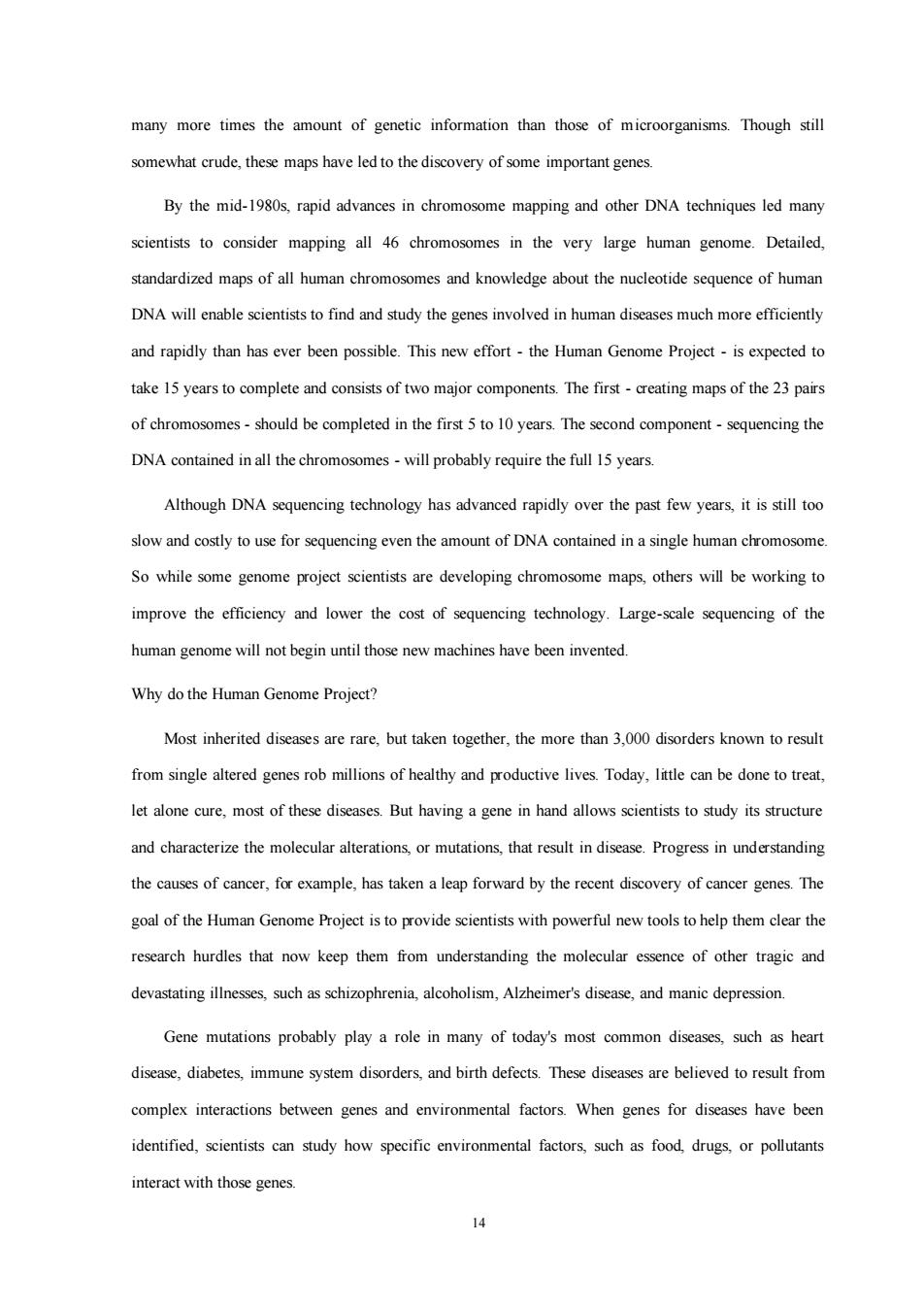正在加载图片...

many more times the amount of genetic information than those of microorganisms.Though still somewhat crude,these maps have led to the discovery of some important genes By the mid-1980s,rapid advances in chromosome mapping and other DNA techniques led many scientists to consider mapping all 46 chromosomes in the very large human genome.Detailed, standardized maps of all human chromosomes and knowledge about the nucleotide sequence of human DNA will enable scientists to find and study the genes involved in human diseases much more efficiently and rapidly than has ever been possible.This new effort-the Human Genome Projectis expected to take 15 years to complete and consists of two major components.The first-creating maps of the 23 pairs of chromosomes-should be completed in the first 5 to 10 years.The second component-sequencing the DNA inall the probably require the full 15 years Although DNA technology has advanced rapidly over the past few years,it issill too slow and costy to use for sequencing even the amount of DNA contained in a single human. So while some genome project scientists are developing chromosome maps,others will be working to improve the efficiency and lower the cost of sequencing technology.Large-scale sequencing of the human genome will not begin until those new machines have been invented. Why do the Human Genome Project? Most inherited diseases are rare.but taken together,the more than 3,000 disorders known to resul from single atered genes rob millions of healthy and productive lives Today,tecan be done to treat. let alone cure,most of these diseases.But having a gene in hand allows scientists to study its structure and characterize the molecular alterationsor mutations,that result indisease.Progress in understanding the causes of cancer,for example,has taken a leap forward by the recent discovery of cancer genes.The goal of the Human Genome Project is to provide scientists with powerful new tools to help them clear the research hurdles that now keep them from understanding the molecular essence of other tragic and such as schizophrenia,alcoholism,Alzheimer's disease.and manic depression Gene mutations probably play a role in many of today's most common diseases,such as heart disease,diabetes immune system disorders,and birth defects These diseases are believed to result from complex interactions between genes and environmental factors.When genes for diseases have been identified,scientists can study how specific environmental factors,such as food,drugs,or pollutants interact with those genes 14 14 many more times the amount of genetic information than those of microorganisms. Though still somewhat crude, these maps have led to the discovery of some important genes. By the mid-1980s, rapid advances in chromosome mapping and other DNA techniques led many scientists to consider mapping all 46 chromosomes in the very large human genome. Detailed, standardized maps of all human chromosomes and knowledge about the nucleotide sequence of human DNA will enable scientists to find and study the genes involved in human diseases much more efficiently and rapidly than has ever been possible. This new effort - the Human Genome Project - is expected to take 15 years to complete and consists of two major components. The first - creating maps of the 23 pairs of chromosomes - should be completed in the first 5 to 10 years. The second component - sequencing the DNA contained in all the chromosomes - will probably require the full 15 years. Although DNA sequencing technology has advanced rapidly over the past few years, it is still too slow and costly to use for sequencing even the amount of DNA contained in a single human chromosome. So while some genome project scientists are developing chromosome maps, others will be working to improve the efficiency and lower the cost of sequencing technology. Large-scale sequencing of the human genome will not begin until those new machines have been invented. Why do the Human Genome Project? Most inherited diseases are rare, but taken together, the more than 3,000 disorders known to result from single altered genes rob millions of healthy and productive lives. Today, little can be done to treat, let alone cure, most of these diseases. But having a gene in hand allows scientists to study its structure and characterize the molecular alterations, or mutations, that result in disease. Progress in understanding the causes of cancer, for example, has taken a leap forward by the recent discovery of cancer genes. The goal of the Human Genome Project is to provide scientists with powerful new tools to help them clear the research hurdles that now keep them from understanding the molecular essence of other tragic and devastating illnesses, such as schizophrenia, alcoholism, Alzheimer's disease, and manic depression. Gene mutations probably play a role in many of today's most common diseases, such as heart disease, diabetes, immune system disorders, and birth defects. These diseases are believed to result from complex interactions between genes and environmental factors. When genes for diseases have been identified, scientists can study how specific environmental factors, such as food, drugs, or pollutants interact with those genes